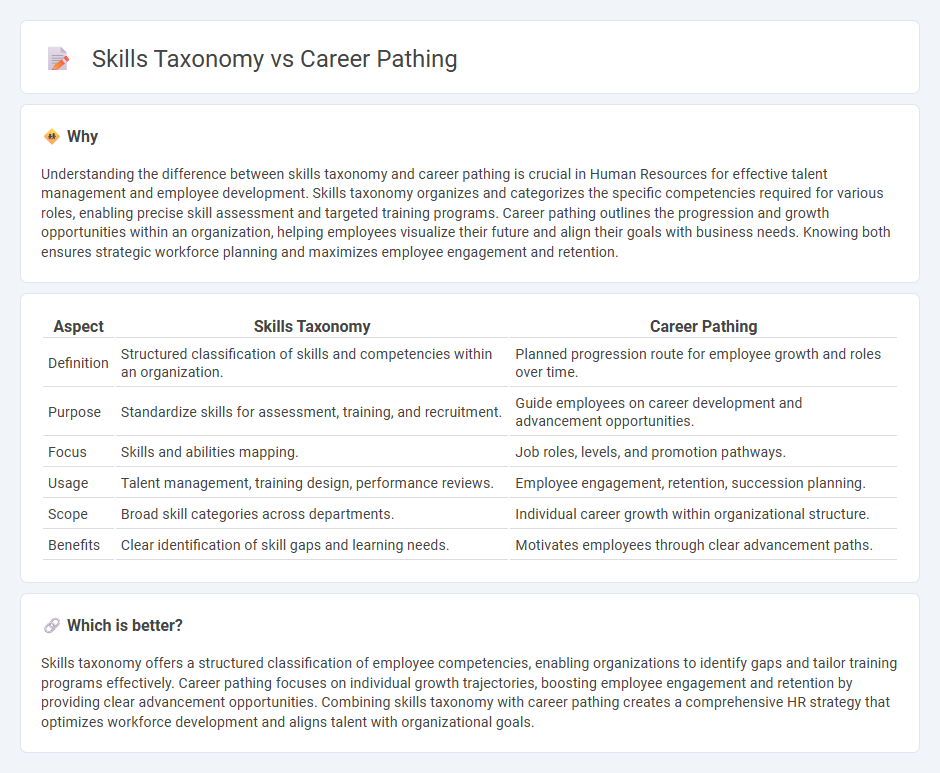
Skills taxonomy organizes and categorizes employee abilities to enhance talent management and training efficiency, while career pathing focuses on mapping the progression opportunities within an organization to align employee growth with business goals. Implementing a well-structured skills taxonomy supports precise skill gap analysis and personalized development plans essential for effective career pathing. Explore how integrating these strategies can optimize workforce development and retention.
Why it is important
Understanding the difference between skills taxonomy and career pathing is crucial in Human Resources for effective talent management and employee development. Skills taxonomy organizes and categorizes the specific competencies required for various roles, enabling precise skill assessment and targeted training programs. Career pathing outlines the progression and growth opportunities within an organization, helping employees visualize their future and align their goals with business needs. Knowing both ensures strategic workforce planning and maximizes employee engagement and retention.
Comparison Table
| Aspect | Skills Taxonomy | Career Pathing |
|---|---|---|
| Definition | Structured classification of skills and competencies within an organization. | Planned progression route for employee growth and roles over time. |
| Purpose | Standardize skills for assessment, training, and recruitment. | Guide employees on career development and advancement opportunities. |
| Focus | Skills and abilities mapping. | Job roles, levels, and promotion pathways. |
| Usage | Talent management, training design, performance reviews. | Employee engagement, retention, succession planning. |
| Scope | Broad skill categories across departments. | Individual career growth within organizational structure. |
| Benefits | Clear identification of skill gaps and learning needs. | Motivates employees through clear advancement paths. |
Which is better?
Skills taxonomy offers a structured classification of employee competencies, enabling organizations to identify gaps and tailor training programs effectively. Career pathing focuses on individual growth trajectories, boosting employee engagement and retention by providing clear advancement opportunities. Combining skills taxonomy with career pathing creates a comprehensive HR strategy that optimizes workforce development and aligns talent with organizational goals.
Connection
Skills taxonomy organizes and categorizes employee competencies, enabling clear identification of required skills for various roles. Career pathing leverages this structured taxonomy to map out progression routes, aligning individual development with organizational needs. This connection enhances workforce planning, talent management, and employee engagement by providing transparent growth opportunities.
Key Terms
**Career Pathing:**
Career pathing strategically maps an employee's progression within an organization, aligning individual goals with business objectives and identifying necessary roles and experiences for advancement. It emphasizes personalized development plans supported by clear milestones and competency frameworks to foster engagement and retention. Explore how career pathing can transform employee growth and organizational success.
Succession Planning
Career pathing maps employee growth trajectories aligning roles with future organizational needs, while skills taxonomy categorizes and organizes competencies critical for succession planning. Effective succession planning integrates career pathing with a well-defined skills taxonomy to identify high-potential employees and prepare them for leadership roles by targeting specific skill gaps. Explore how combining these frameworks can optimize your succession planning strategy and ensure leadership continuity.
Job Progression
Career pathing emphasizes structured job progression by outlining potential roles and advancement opportunities within an organization, enabling employees to visualize their professional growth. Skills taxonomy categorizes and organizes skills required across roles, supporting targeted development but focusing less on linear progression. Explore how integrating both approaches enhances strategic workforce planning and accelerates career development.
Source and External Links
What Is Career Pathing & Why Is It Important? - Career pathing is the process employers use to create a plan and development track that helps employees visualize how their skills and interests align with career objectives, outlining possible roles and growth opportunities within or beyond the company.
Career Pathing: The Complete Guide - Career pathing involves planning career steps using two common approaches: a career ladder (linear promotions) or a career lattice (lateral moves and flexible role design), supporting varied paths for professional growth.
Improve Employee Development with Career Pathing - Career pathing boosts employee engagement and retention through a three-step process: self-assessment, individualized career mapping, and exploring opportunities for advancement in the company.
 dowidth.com
dowidth.com